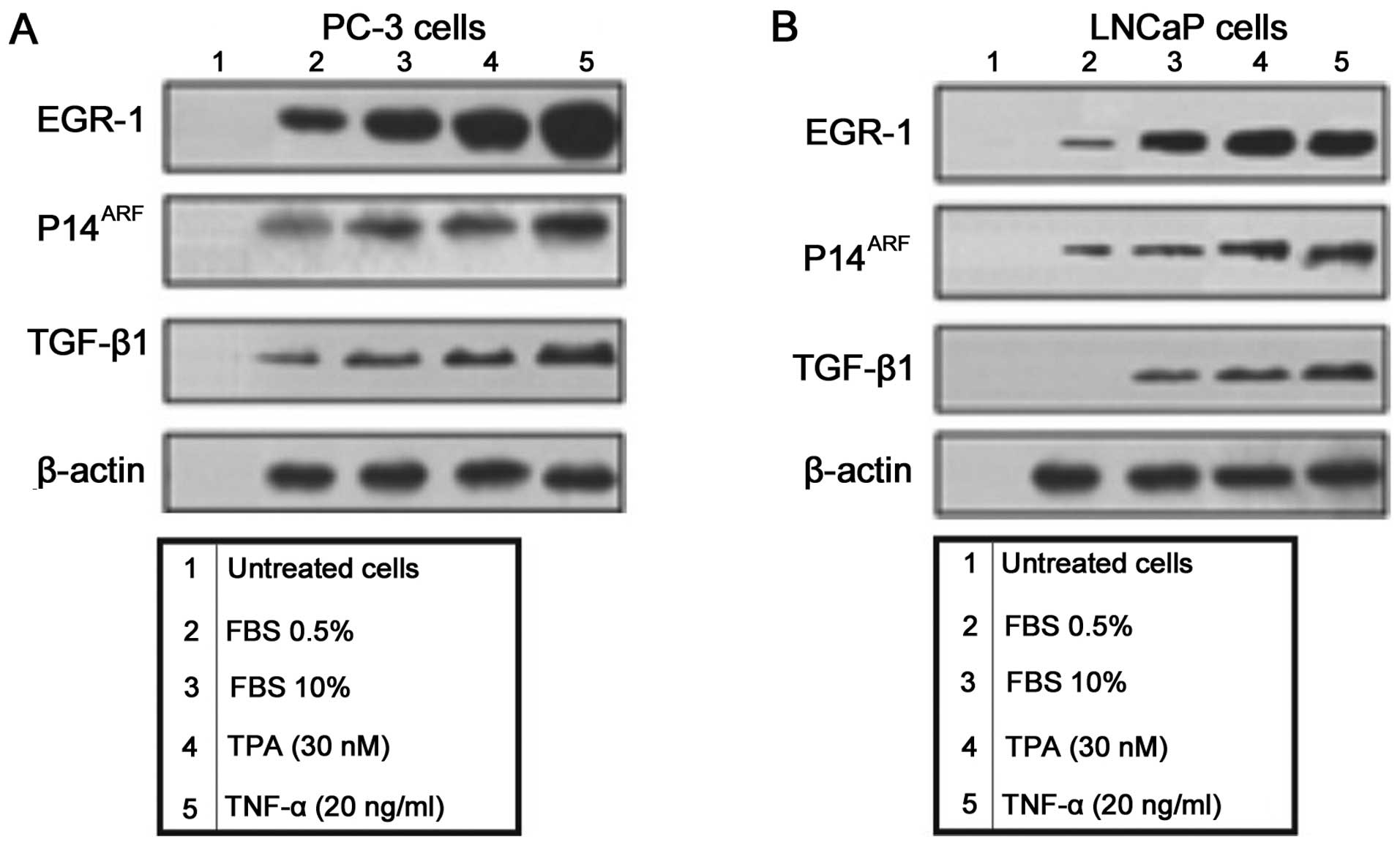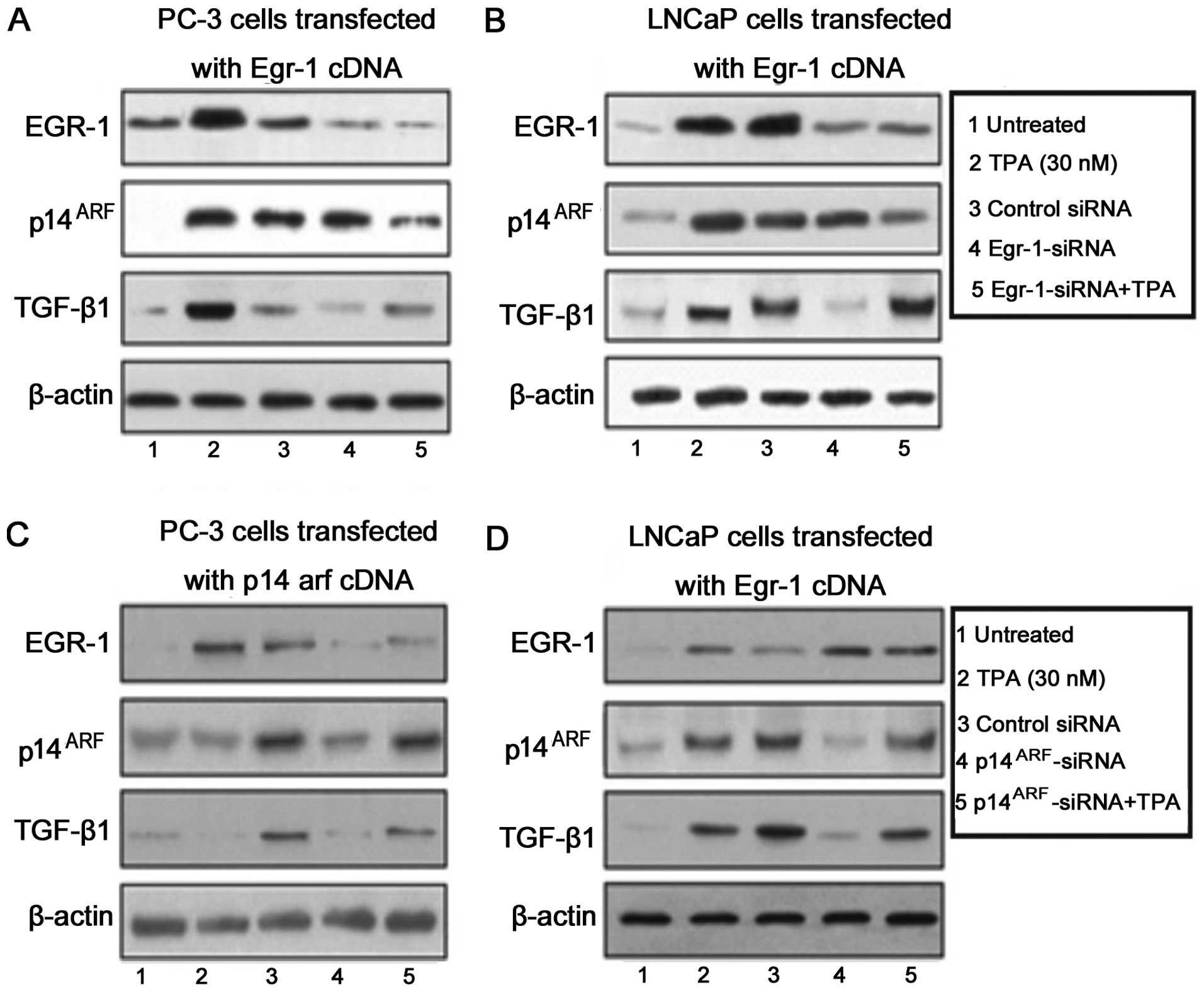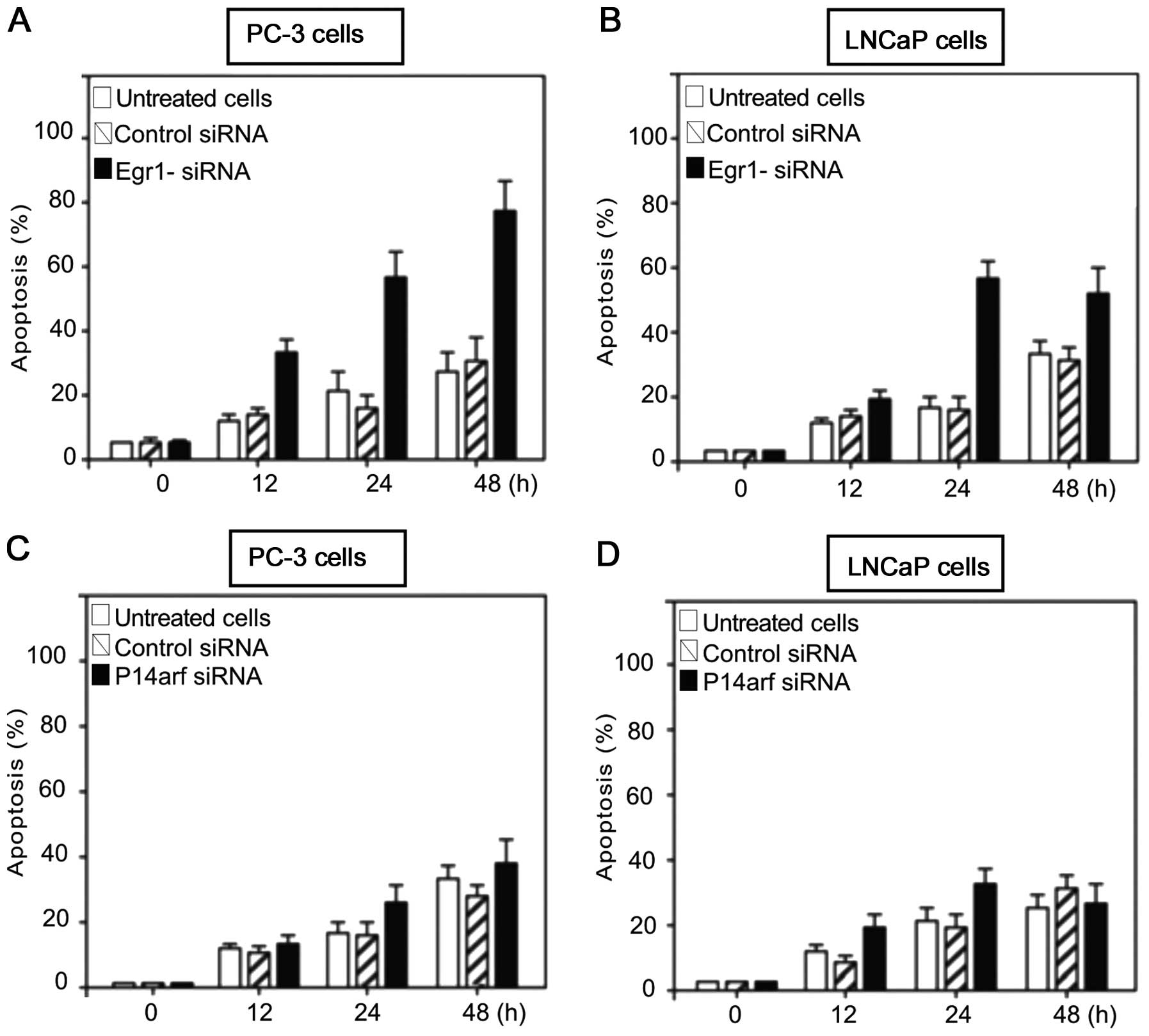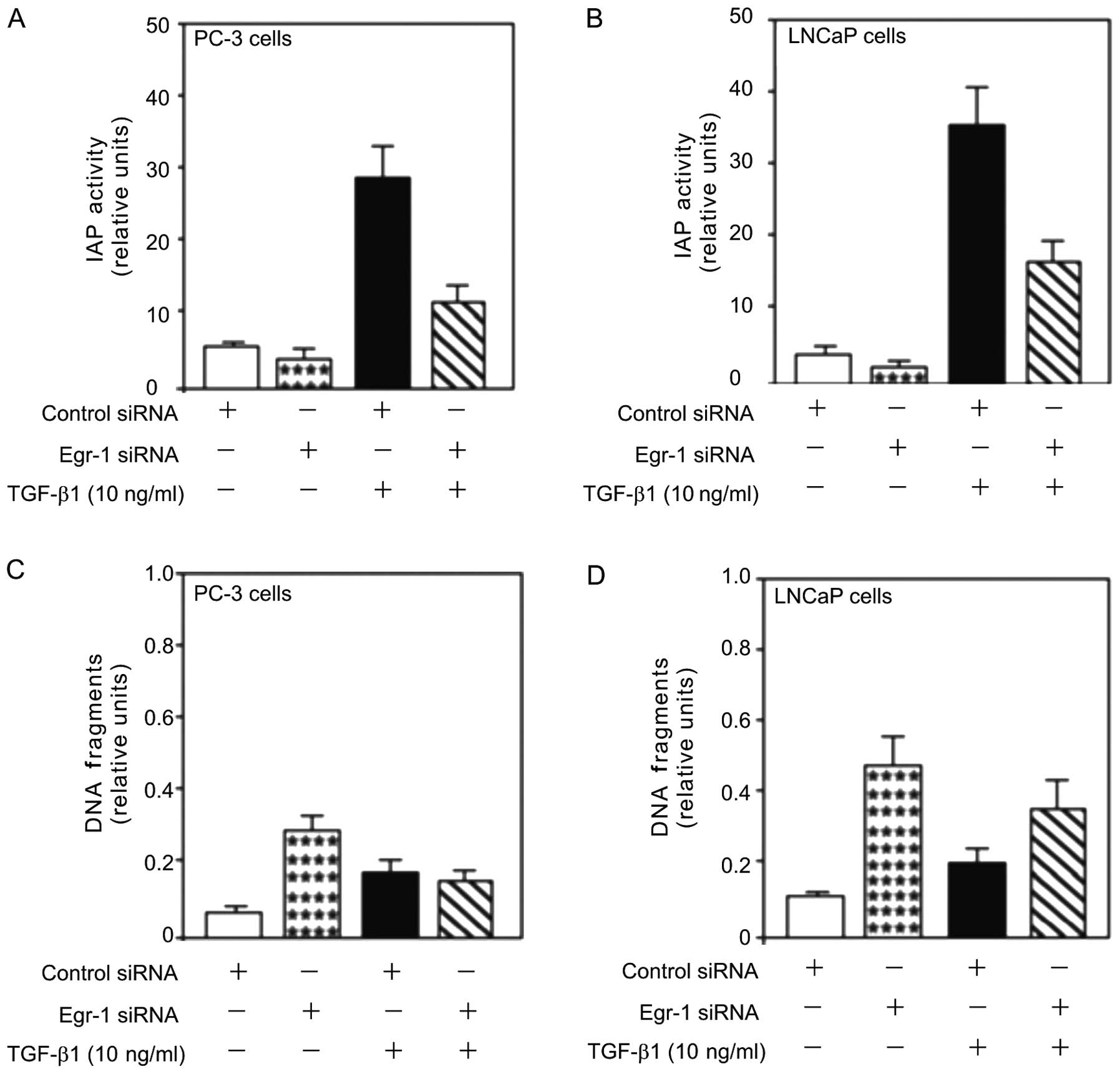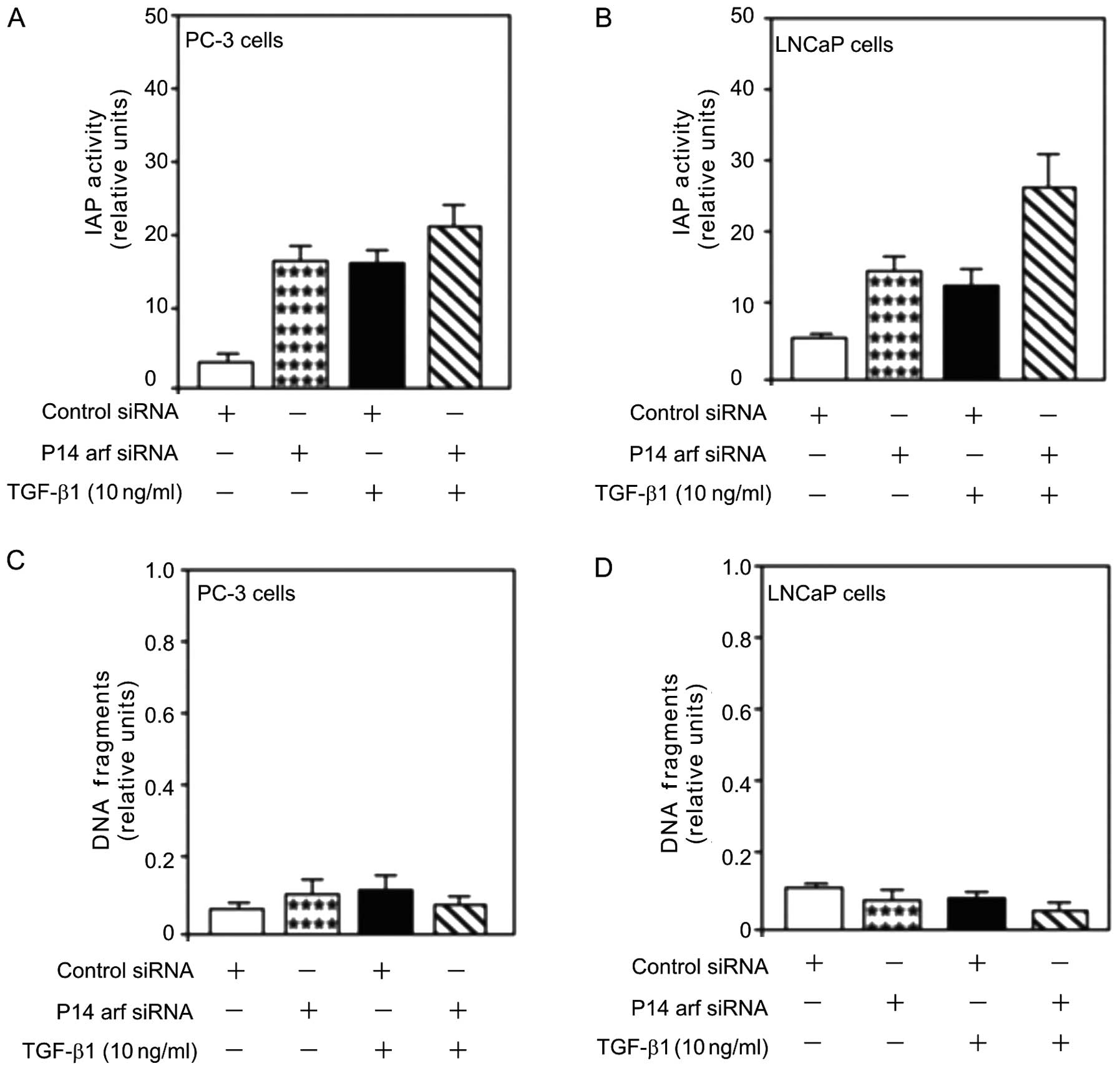Association of increased levels of TGF-β1 and p14ARF in prostate carcinoma cell lines overexpressing Egr-1
- Authors:
- Published online on: September 9, 2014 https://doi.org/10.3892/or.2014.3472
- Pages: 2191-2198
Abstract
Introduction
EGR-1 belongs to the class of transcription factors known as immediate-early genes and is rapidly induced by growth factors to transduce the proliferative signal. Egr-1 induction by external stimuli is generally transient; however, it seems to be sustained in some prostate tumor cell lines and tumors, suggesting that Egr-1 stimulates tumor cell growth, which may be important as its expression level is enhanced with the degree of malignancy as measured by the Gleason tumor grade (1). This increase seems to be specific to prostate tumor cells as Egr-1 expression is low in mammary and lung tumors, as well as most normal tissues (2–6). By contrast, in breast, lung and brain tumor, Egr-1 expression is often not present or decreased and when re-expressed, results in growth inhibition (2,3,7,8). The induction of Egr-1 by external stimuli is generally transient but appears to be sustained in some prostate tumor cell lines and tumors, suggesting that Egr-1 stimulates tumor cell growth (9,10). Egr-1 is also involved in the regulation of p53 in human melanoma cells leading to apoptosis (11–13). The proapoptotic tumor-suppressor gene PTEN is also directly regulated by EGR-1 (14). Previously, it was demonstrated that the overexpression of Egr-1 in PC-3 and LNCaP prostate carcinoma cell lines increases cell growth and independent anchorage (15). Moreover, ablation of Egr-1 expression using small interfering RNA (siRNA) resulted in the induction of cell apoptosis and cell death (15–18).
Another important factor associated with EGR-1 regulation is the transforming growth factor β1 (TGF-β1) (19). It has been previously shown that the expression of EGR-1 in the HT1080 human fibrosarcoma cell line, increases the secretion of transforming growth factor-β1 (TGF-β1) in direct proportion to the amounts of EGR-1 expressed (20), and that EGR-1 protein specifically binds to two GC-rich EGR-l-binding sites in the TGF-β1 gene promoter and stimulates TGF-β1 promoter activity in HT1080 cells (20). TGF-β1 is a potent suppressive cytokine that inhibits immune system functions that otherwise may be effective in generating antitumor immunity. TGF-β is produced by many normal cells and is overexpressed in the tumor cells that comprise the most common forms of human cancer, including prostate carcinoma. TGF-β1 is induced by a variety of signals including those of oncogenes and immediate-early genes, whereas the expression of TGF-β2 and TGF-β3 is considerably more developmentally and hormonally regulated (21). Thus, TGF-β1 influences various pathologies including fibrosis, parasite induction, autoimmune diseases and tumorigenesis (22–25). Another protein that is involved in the regulation of EGR-1 is p14ARF. This protein has emerged as an important tumor suppressor that can trigger the growth suppression and apoptosis of many cancer cells by a p53-dependent and -independent mechanism (26,27), and loss of p14ARF is likely to contribute to the failure of apoptosis in cancer. p14ARF is encoded within the same INK4a locus that encodes the p16 cyclin-dependent kinase inhibitor (27,28). Unlike p16, which inhibits cell cycle progression, p14ARF does not appear to have Cdk inhibitory activity. Instead, p14ARF stabilized p53 function through a complex formation with Mdm2, the principle mediator of p53 stability (29,30). A previous study demonstrated that EGR-1 binds to p14ARF which is associated with the tumor-suppressive effects of EGR-1 (31).
The results showed that TGF-β1 and p14ARF activities in the presence of EGR-1 overexpression exist independently of the presence of cells carrying a mutant p53 (PC-3 cells) or cells carrying a wild-type p53 (LNCaP cells). The effect of EGR-1 on the growth of prostate cells may occur through multiple mechanisms, but be independent of p53 expression control.
Materials and methods
Cell lines and culture
Human prostate carcinoma cell lines PC-3 and LNCaP were a kind gift from Dr Dan Mercola (The SKCC; Sidney Kimmel Cancer Center, La Jolla, CA, USA). The cells were cultured in RPMI-1640 medium supplemented with 100 ml/l fetal bovine serum (FBS), 8×105 U/l penicillin and 0.1 g/l streptomycin in humidified incubator containing 50 ml/l CO2 at 37°C.
Tris-borate-EDTA and acrylamide:bisacrylamide (29:1) were obtained from Bio-Rad Laboratories (Richmond, CA, USA). Egr-1 antibody was purchased from Santa Cruz Biotechnology, Inc. (Santa Cruz, CA, USA). Lipofectamine was purchased from Life Technologies, Inc. (Carlsbad, CA, USA) and TNF-α from Sigma Chemical Co. (St. Louis, MO, USA). Complete Mini-EDTA-Free Protease Inhibitor Cocktail Tablets and Annexin-V-Fluos were purchased from Roche Diagnostics GmbH (Mannheim, Germany). Other reagents were purchased from Sigma Chemical Co. (Taufkirchen, Germany). Phorbol 12-myristate 13-acetate (TPA), TNF-α and TGF-β1 were purchased from Stratagene Inc. (La Jolla, CA, USA). Anti-Egr-1, anti-p14ARF, anti-TGF-β1, and β-actin antibodies were purchased from Santa Cruz Biotechnology.
siRNA preparation and transfection of small interfering RNA
The sequences designed used to specifically target human p14ARF and Egr-1 RNAs were: for p14ARF, 5′-GAACAUGGU GCGCAGGUUCTT-3′; and for Egr-1, 5′-AACGCAAGAGGC AUACCAAGA-3′. The scrambled small interfering RNA (siRNA) oligonucleotides used as controls for all RNA interference experiments were: 5′-AAAGGUGACGCUGACGAA GTT-3′ and 5′-CAAGAAAGGCCAGUCCAAGTT-3′. The cells were transfected with siRNA oligonucleotide duplexes and cultured in medium without antibiotics 24 h prior to transfection resulting in a confluence of the cell monolayer by 60–80%. Egr-1-siRNA or non-silencing siRNA (70 nmol) were mixed with Lipofectamine™ 2000 (Invitrogen-Life Technologies) according to the manufacturer’s recommendation and added to the cells. After 6 h at 37°C, the medium was replaced and the cells were cultivated in RPMI-1640 supplemented with 10% heat-inactivated FBS (9,16,17).
3-(4,5-methylthiazol-2-yl)-2,5-diphenyltetrazolium bromide (MTT) assay
PC-3 and LNCaP cells (5×105) were placed in 96-well plates in RPMI-1640 containing 10% FBS at a final volume of 0.1 ml. The following day, the cells were treated with the pTER siRNA. MTT was added (20 ml/well of 5 g/l solution in PBS) after culture for 24, 48 and 72 h. Following incubation at 37°C for 4 h, the reaction was stopped by the addition of 100 ml DMSO. The reaction product was quantified by measuring the absorbance at 490 nm using an ELISA reader (WALLAC 1420 VICTOR 2; Wallac, Turku, Finland) and the Software HT-Soft (Perkin-Elmer). The samples were assayed repeatedly in 6-wells.
Western immunoblot analysis
PC-3 and LNCaP prostate carcinoma cells lines (5×105) were seeded in 6-well plates. Forty-eight hours after transfection, the cells were collected and washed twice by cold PBS, and each well was treated with 50 ml lysis buffer (2 mmol/l Tris-HCl pH 7.4, 50 mmol/l NaCl, 25 mmol/l EDTA, 50 mmol/l NaF, 1.5 mmol/l Na3VO4, 1% Triton X-100, 0.1% SDS, supplemented with protease inhibitors 1 mmol/l phenylmethylsulfonylfluoride, 10 mg/l pepstatin, 10 mg/l aprotinin and 5 mg/l leupeptin) (all from Sigma). Protein concentrations were determined using the Bradford protein assay. Equal amounts of protein (40 mg) were separated on a 15% SDS polyacrylamide gel and transferred to a nitrocellulose membrane (Hybond C; Amersham, Freiburg, Germany). The membranes were blocked in 5% non-fat dry milk in TBS for 1 h at room temperature and probed with rabbit anti-Egr-1 antibodies (1:500 dilution; Santa Cruz Biotechnology) overnight at 4°C. After being washed 3 times with TBS containing 0.1% Tween-20, the membranes were incubated with anti-rabbit IgG-horseradish-peroxidase (1:5,000; Santa Cruz Biotechnology), and developed by luminol-mediated chemiluminescence (Appylgen Technologies Inc., Beijing, China). To confirm equal protein loading, membranes were reprobed with a 1:1,000 dilution of an anti-actin antibody (Santa Cruz Biotechnology). Densitometric analyses were performed using Scion Image software. Intestinal alkaline phosphatase (IAP) activity was detected using an IAP kit from Sigma-Aldrich.
DNA fragmentation assay
The cells were plated in 96-well plates 24 h prior to treatment. Following treatment, DNA fragmentation was evaluated by examination of cytoplasmic histone-associated DNA fragments (mononucleosomes and oligonucleosomes) using a Cell Death Detection ELISA kit (Roche Molecular Biochemicals, Indianapolis, IN, USA) according to the manufacturer’s instructions.
Flow cytometry
PC-3 and LNCaP prostate carcinoma (5×105) cell lines were seeded in triplicate in 6-well plates, and cultured in RPMI-1640 supplemented with 100 ml/l FBS. After transfection for 48 h, the cells were collected and washed with ice-cold PBS, and fixed in 70% ethanol overnight at 4°C. The fixed cells were pelleted, washed in PBS, resuspended in PBS containing 0.1 mg/ml of propidium iodide and analysed by flow cytometry.
Results
Expression of EGR-1, p14ARF and TGF-β in human prostate carcinoma cell lines overexpressing Egr-1
EGR-1 is an early response nuclear factor that is important in the regulation of several genes (Fig. 1). To determine the effect of overexpressing Egr-1 in the expression of EGR-1, p14ARF and TGF-β1 in PC-3 (Fig. 1A) and LNCaP (Fig. 1B), prostate carcinoma cell lines the cells were treated with FCS 0.5%, FCS 10%, TPA (30 nM) and TNF-α (20 ng/ml). The protein expression of EGR-1, p14ARF and TGF-β1 was assessed by western blot analysis (Fig. 1).
Knocking down Egr-1 expression by Egr-1-siRNA, strongly decreased the activity of TGF-β 1 but only moderately the expression of p14ARF and was able to reverse the increasing effect of TPA (30 nM) only in PC-3 cells
PC-3 (Fig. 2A) and LNCaP (Fig. 2B) prostate carcinoma cells were transfected with a wild-type Egr-1-cDNA and the expression of EGR-1, TGF-β1 and p14ARF proteins was assessed by western blot analysis (Fig. 2A and B). We observed a strong induction of Egr-1 and p14ARF after the treatment of cells with TPA and TNF-α treatment (Fig. 2A and B, lanes 1 and 2). By contrast, TGF-β1 was significantly induced only after TNF-α treatment in PC-3 cells (Fig. 2A, lane 3). The expression of TGF-β1 in LNCaP cells was observed after treatment with TPA and TNF-α treatment (Fig. 2B, lanes 2, 3 and 5). A decrease in the cell protein expression in the PC-3 (Fig. 2A) and LNCaP (Fig. 2B) prostate carcinoma cells was observed following Egr-1 siRNA treatment (Fig. 2A and B, lane 4). Nevertheless, Egr-1-siRNA was unable to reverse the effect of TPA in the induction of TGF-β1 in LNCaP cells (Fig. 2B, lane 5).
To determine whether blocking the expression of p14arf by a siRNA against p14arf affected the expression of EGR-1, p14arf or TGF-β1, PC-3 (Fig. 2C) and LNCaP (Fig. 2D) cells were transfected with a vector carrying a p14arf cDNA. At 72 h after transfection, the cells were treated with TPA (30 mM), TNF-α (20 ng/ml) and siRNA against p14arf and cultured for an additional 12 h. At the indicated time point, the cells were harvested and analyzed for expression of EGR-1, p14ARF and TGF-β1. The protein expression was assessed by western blot analysis. As shown in Fig. 2C and D, p14arf-siRNA strongly decreased EGR-1 and p14ARF expression but was unable to reverse the effect of TPA.
Inhibition of Egr-1 but not p14arf increased apoptosis in PC-3 and LNCaP prostate carcinoma cell lines
We determined whether blocking Egr-1 or p14arf expression exerted an apoptotic effect on PC-3 or LNCaP cells treated with siRNA against the abovementioned proteins. To this effect, LNCaP cells were transfected with siRNA against Egr-1 (Fig. 3A) or against p14arf (Fig. 3B) and with a non-specific siRNA as the control. After culturing at the indicated times, the cells were harvested and analysed for induction of apoptosis. Results of the flow cytometric analysis showed that knocking down Egr-1 using siRNA against Egr-1, significantly induced apoptosis in PC-3 and LNCaP cells (Fig. 3A and B). However, when PC-3 and LNCaP cells were treated with p14arf-siRNA and analysed for induction of apoptosis, the effect was only moderate (Fig. 3C and D) and decreased after a 48-h transfection, suggesting a moderate role for p14arf inhibition in controlling apoptosis. However, unlike Egr-1-siRNA-treated PC-3 cells, the apoptotic activity decreased after 48 h as compared to that observed in Fig. 3A and B. The results suggested that the differential expression of EGR-1 and p53 was responsible for the differences in apoptotic response demonstrated in PC-3 and LNCaP cells (Fig. 3).
Egr-1 function in TGF-β1 induced proliferation and cell survival
Since EGR-1 is a potential tumor inducer for prostate cancer (1) and inhibition of Egr-1 by siRNA-Egr-1 decreases TGF-β1-mediated proliferation (6), we analysed the role of Egr-1 in TGF-β1-induced cell survival in PC-3 and LNCaP cells. Treatment with TGF-β1 (10 ng/ml) increased IAP activity (Fig. 4A and B), an inhibitor of apoptosis that plays a key role in preventing cell death by apoptosis. However, this increase was attenuated by the transfection of siRNA against Egr-1 (Egr-1-siRNA), suggesting a role for Egr-1 in TGF-β1-mediated cell viability.
The aforementioned results showed that inhibition of Egr-1 by siRNA enhanced TGF-β1-mediated cell viability in human prostate cancer cells (Fig. 4A and B). The effect of Egr-1 knockdown on TGF-β1-induced PC-3 and LNCaP cell survival was assessed. TGF-β1 induced obvious cell survival as shown by the decreased DNA fragmentation in the PC-3 and LNCaP cells (Fig. 4C and D) and this decrease was partially attenuated by the knockdown of Egr-1 using Egr-1-siRNA transfection. Inhibition of Egr-1 expression induced obvious cell death as shown by the increased DNA fragmentation (Fig. 4C and D), suggesting a survival role of Egr-1 in prostate cancer progression. Collectively, the results suggested that Egr-1 is involved in TGF-β-mediated prostate cell death, survival and differentiation.
p14arf function in TGF-β1 induced proliferation and cell survival
The role of p14ARF-induced cell death in PC-3 and LNCaP cells was assessed. Treatment with TGF-β1 (10 ng/ml) increased IAP activity (Fig. 5A and B), an inhibitor of apoptosis. However, unlike Egr-1 (Fig. 4A and B), this increase was not attenuated by the transfection of siRNA against p14ARF (p14arf-siRNA) suggesting a key role of TGF-β1-mediated proliferation in allowing cell viability in human prostate cancer cells (Fig. 5A and B).
The effect of p14arf knockdown on TGF-β1-induced PC-3 and LNCaP cell survival was examined. TGF-β1 induced obvious cell survival as shown by the decreased DNA fragmentation in the PC-3 and LNCaP cells (Fig. 5C and D). This decrease was not attenuated by the knockdown of p14arf using p14arf-siRNA transfection. Inhibition of p14arf expression induced obvious cell survival as shown by the decreased DNA fragmentation (Fig. 5C and D), suggesting a cell death role for p14arf in prostate cancer. Collectively, our results suggested that Egr-1 plays a role in TGF-β1 and p14arf-mediated prostate cell death, survival and differentiation.
Discussion
In previous studies, we demonstrated decreased prostate carcinoma cell survival and independent anchorage by Egr-1-siRNA (15,16) and defined a novel feedback regulation of EGR-1 through the regulation of NF-κB and AP-1 (10). In the present study, we delineated the signaling pathway involved in this regulation. The results of the present study show that TGF-β1-treated cells increased EGR-1 expression and decreased the p14ARF suppressor effect in PC-3 and LNCaP prostate carcinoma cell lines. This TGF-β1-mediated EGR-1 induction and further enhancement in the increase of EGR-1 expression was independent of the presence or absence of the tumor suppressor protein p14ARF. Treatment of the PC-3 and LNCaP prostate carcinoma cell lines with TPA (30 nM) or TNF-α (20 ng/ml) activated EGR-1, JNK-1 and JNK-3 (32) and attenuated cell apoptosis (32). Findings of a recent study have shown that the treatment of PC-3 and LNCaP cells with Egr-1-siRNA induced cell survival, which was associated with the activation p21Waf1/Cip1 protein and with a decreased JNK expression (33). By contrast, inhibition of JNK by a siRNA, did not attenuate EGR-1 expression (18). Our observation that the blockade of EGR-1 by a genetic mechanism (transfection of Egr-1-siRNA) attenuated TGF-β1 induction, while it did not affect p14ARF induction, suggests a functional role for EGR-1 activation in TGF-β1 induction in PC-3 and LNCaP prostate carcinoma cell lines. The induction of proliferation by TGF-β1 via the induction of EGR-1 may play a role in the autonomy of prostate carcinoma cell growth and, thus, in the pathogenesis of prostate cancer.
EGR-1 expression in certain cells, such as breast and lung carcinoma cells, as well as most normal tissues, is low (10). In addition, EGR-1 overexpression is correlated with loss of its co-repressor NAB2 in primary prostate carcinoma (6–9). This disruption of the balance between EGR-1 and NAB2 expression results in high EGR-1 transcriptional activity in prostate carcinoma cells (6).
Crosstalk between EGR-1 and TGF-β1 pathway has been previously reported (34). The levels of EGR-1 protein and mRNA were rapidly and transiently upregulated by TGF-β1 in vitro, and EGR-1 promoter activity was enhanced. Liu et al (25) observed that the EGR-1 gene product directly controls TGF-β1 gene expression. Another study showed that TGF-β1 treatment also activated the ERK1/2 signaling pathway, causing an increase in EGR-1 (35). However, the tumor-suppressor p14ARF protein showed antagonist activity to the effect induced by EGR-1 in PC-3 and LNCaP cells. Previously, Egr-1 and PTEN were identified as mediators of p14ARF function (36). Egr-1-dependent expression of PTEN is controlled by p14ARF through the ARF-mediated sumoylation of Egr-1. This requires the phosphorylation of Egr-1 by the protein kinase AKT, which promotes the association of Egr-1 with p14ARF fibroblasts or ARF-/-ARF (36). p14ARF has been identified as a potent tumor suppressor in vitro and in vivo (37,38). p14ARF has been shown to protect against uncontrolled growth and tumorigenesis induced by hyper-proliferative stimuli (39). In agreement with these findings, results of this study have shown that inhibition of p14ARF attenuated cell apoptosis, leading to the enhancement of EGR-1 induction. p14ARF was found to be primarily dependent on the presence of functional p53. However, p14ARF is involved in p53-independent mechanisms of cell cycle regulation and apoptosis induction, respectively. Failure of apoptosis is central to the development of cancer, and in many types of cancer, this failure results from loss of p53, a key mediator of apoptosis (40). Consequently, the tumor-suppressor p14ARF appears to be a possible target of the EGR-1 pathway.
In summary, the present study provides important insights regarding the signaling mechanisms regulating EGR-1 expression and function in prostate carcinoma cell lines. The importance of the antagonistic crosstalk between EGR-1 and p14ARF in prostate carcinoma cell lines deserves further investigation as a novel approach to cancer therapy.
Acknowledgements
We would like to thank Dr Peter T. Daniel, Department of Hematology, Oncology and Tumor Immunology, University Medical Center Charité, Campus Berlin-Buch, D-13125 Berlin-Buch, Germany for providing the vector expressing the p14ARF cDNA. The present study was supported by the Intramural Regular Research Grant from the University of Tarapaca UTA-6710-14.
References
|
Eichelberger L, Koch OM, Eble J, Ulbright T, Juliar B and Cheng L: Maximum tumor diameter is an independent predictor of prostate-specific antigen recurrence in prostate cancer. Mod Pathol. 18:886–890. 2005. View Article : Google Scholar : PubMed/NCBI | |
|
Virolle T, Krones-Herzig A, Baron V, Gregorio GG, Adamson ED and Mercola D: Egr-1 promotes growth and survival of prostate cancer cells: identification of novel Egr-1 target genes. J Biol Chem. 278:11802–11810. 2003. View Article : Google Scholar : PubMed/NCBI | |
|
Eid MA, Kumar MV, Iczkowski KA, Bostwick DG and Tindall DJ: Expression of early growth response genes in human prostate cancer. Cancer Res. 58:2461–2468. 1998.PubMed/NCBI | |
|
Scharnhorst V, Menke AL and Attema J: EGR-1 enhances tumor growth and modulates the effect of the Wilms’ tumor 1 gene products on tumorigenicity. Oncogene. 19:791–800. 2000.PubMed/NCBI | |
|
Pignatelli M, Luna-Medina R, Perez-Rendon A, Santos A and Perez-Castillo A: The transcription factor early growth response factor-1 (EGR-1) promotes apoptosis of neuroblastoma cells. Biochem J. 373:739–746. 2003. View Article : Google Scholar : PubMed/NCBI | |
|
Houston P, Campbell CJ, Svaren J, Milbrandt J and Braddock M: The transcriptional corepressor NAB2 blocks Egr-1-mediated growth factor activation and agiogenesis. Biochem Biophys Res Commun. 283:480–486. 2001. View Article : Google Scholar : PubMed/NCBI | |
|
Adamson ED and Mercola D: Egr-1 transcription factor, multiple roles in prostate tumor cell growth and survival. Tumour Biol. 23:93–102. 2002. View Article : Google Scholar : PubMed/NCBI | |
|
Banks MF, Gerasimovskaya EV, Tucker D, Frid MG, Carpenter TC and Stenmark KR: Egr-1 antisense oligonucleotides inhibit hypoxia-induced proliferation of pulmonary artery adventitial fibroblast. J Appl Physiol. 98:732–738. 2004. View Article : Google Scholar : PubMed/NCBI | |
|
Parra E, Ferreira J and Ortega A: Overexpression of EGR-1 modulates the activity of NF-κB and AP-1 in prostate carcinoma PC-3 and LNCaP cell lines. Int J Oncol. 39:345–352. 2011.PubMed/NCBI | |
|
Yang SZ and Abdulkadir S: Early growth response gene 1 modulates androgen receptor signaling in prostate carcinoma cells. J Biol Chem. 278:39906–39911. 2003. View Article : Google Scholar : PubMed/NCBI | |
|
Liu C, Yao J, Mercola D and Adamson E: The transcription factor EGR-1 directly transactivates the fibronectin gene and enhances attachment of human glioblastoma cell line U251. J Biol Chem. 275:20315–20323. 2000. View Article : Google Scholar : PubMed/NCBI | |
|
Krones-Herzig A, Mittal S, Yule K, Liang H and English C: Early growth response 1 acts as a tumor suppressor in vivo and in vitro via regulation of p53. Cancer Res. 65:5133–5141. 2005. View Article : Google Scholar : PubMed/NCBI | |
|
Sumathi P, Muthukkumar S, Han S, Sukhatme V and Rangnekar V: Early growth response-1-dependent apoptosis is mediated by p53. J Biol Chem. 272:20131–20138. 1997. View Article : Google Scholar : PubMed/NCBI | |
|
Virolle T, Adamson ED, Baron V, Birle D, Mustelin T and de Belle I: The Egr-1 transcription factor directly activates PTEN during irradiation-induced signalling. Nat Cell Biol. 3:1124–1128. 2001. View Article : Google Scholar : PubMed/NCBI | |
|
Parra E, Ortega A and Saenz L: Downregulation of Egr-1 by siRNA inhibits growth of human prostate carcinoma cell line PC-3. Oncol Rep. 22:1513–1518. 2009.PubMed/NCBI | |
|
Parra E, Ferreira J and Saenz L: Inhibition of Egr-1 by siRNA in prostate carcinoma cell lines is associated with decreased expression of AP-1 and NF-κB. Int J Mol Med. 28:847–853. 2011.PubMed/NCBI | |
|
Parra E, Gutiérrez L and Ferreira J: Increased expression of p21Waf1/Cip1 and JNK with costimulation of prostate cancer cell activation by an siRNA Egr-1 inhibitor. Oncol Rep. 30:911–916. 2013. | |
|
Parra E, Ferreira J and Gutierrez L: Decreased c-Abl activity in PC-3 and LNCaP prostate cancer cells overexpressing the early growth response-1 protein. Oncol Rep. 31:422–427. 2014.PubMed/NCBI | |
|
Letterio JJ and Roberts AB: Regulation of immune response by TGF-β. Annu Rev Immunol. 16:137–161. 1998. | |
|
Liu C, Yao J, de Belle I, Huang RP, Adamson E and Mercola D: The transcription factor EGR-1 suppresses transformation of human fibrosarcoma HT1080 cells by coordinated induction of transforming growth factor-beta1, fibronectin, and plasminogen activator inhibitor-1. J Biol Chem. 247:4400–4411. 1999. View Article : Google Scholar | |
|
Danielpour D, Dart LL, Flanders KC, Roberts AB and Sporn MB: Immunodetection and quantitation of the two forms of transforming growth factor-beta-1 and TGF-beta-2 secretion by cells in culture. J Cell Physiol. 138:79–86. 1989. View Article : Google Scholar : PubMed/NCBI | |
|
Roberts AB and Sporn MB: Differential expression of the TGF-β isoforms in embryogenesis suggests specific roles in developing and adult tissue. Mol Reprod Dev. 32:91–98. 1992. | |
|
Millan FA, Denhez F, Kondaiah P and Akhurst RJ: Embryonic gene expression patterns of TGF beta 1, beta 2 and beta 3 suggest different developmental functions in vivo. Development. 111:131–143. 1991.PubMed/NCBI | |
|
Robert AB and Sporn MB: Physiological actions and clinical applications of transforming growth factor-β (TGF-β). Growth Factors. 8:1–9. 1993. | |
|
Liu Y, Liu H, Li J, Nadalin S, Konigsrainer A, Weng H, Dooley S and Dijke P: Transforming growth factor-β (TGF-β)-mediated connective tissue growth factor (CTGF) expression in hepatic stellate cells requires Stat3 signaling activation. J Biol Chem. 88:30708–30719. 2013. | |
|
Inoue K, Roussel MF and Sherr CJ: Induction of ARF tumor suppressor gene expression and cell cycle arrest by transcription factor DMP1. Proc Natl Acad Sci USA. 96:3993–3998. 1999. View Article : Google Scholar : PubMed/NCBI | |
|
Mao L, Merlo A, Bedi G, Shapiro GI, Edwards CD, Rollins BJ and Sidransky D: A novel p16INK4a transcrpt. Cancer Res. 55:2995–2997. 1995.PubMed/NCBI | |
|
Kamijo T, Weber JD, Zambetti G, Zindy F, Roussel MF and Sherr C: Functional and physical interactions of the ARF tumor suppressor with p53 and Mdm2. Proc Natl Acad Sci USA. 95:8292–8297. 1998. View Article : Google Scholar : PubMed/NCBI | |
|
Haupt Y, Maya R, Kazaz A and Oren M: Mdm2 promotes the rapid degradation of p53. Nature. 387:296–299. 1997. View Article : Google Scholar : PubMed/NCBI | |
|
Kubbutat MH, Jones SN and Vousden KH: Regulation of stability by mdms. Nature. 387:299–303. 1997. View Article : Google Scholar | |
|
Woods YL, Xirodimas DP, Prescott AR, Sparks A, Lane DP and Saville MK: p14 Arf promotes small ubiquitin-like modifier conjugation of Werners helicase. J Biol Chem. 279:50157–50166. 2004. View Article : Google Scholar : PubMed/NCBI | |
|
Yu J, Zhang SS, Saito K, Williams K, Arimura Y, Ma Y, Ke Y, Baron V, Mercola D, Feng GS, Adamson E and Mustelin T: PTEN regulation by Akt-Egr-1-ARF-PTEN axis. EMBO J. 28:21–33. 2009. View Article : Google Scholar : PubMed/NCBI | |
|
Parra E: Inhibition of JNK-1 by small interference RNA induces apoptotic signalling in PC-3 prostate cancer cells. Int J Mol Med. 30:923–930. 2012.PubMed/NCBI | |
|
Parra E and Ferreira J: Modulation of the proliferative response of prostate cancer cells to cisplatin treatment by JNK-1/JNK-2 siRNA. Oncol Rep. 30:1936–1942. 2013. | |
|
Friedrich B, Janessa A, Artunc F, Karl-Aicher W, Muller GA, Alexander D and Risler T: DOCA and TGF-β induce early growth response gene-1 (Egr-1) expression. Cell Physiol Biochem. 22:465–474. 2008. | |
|
Rodriguez-Barbero A, Obreo J, Alvarez P, Pandiella A, Bernabeu C and Lopez-Novoa JM: Endoglin modulation of TGF-beta1-induced collagen synthesis is dependent on ERK1/2 MAPK activation. Cell Physiol Biochem. 18:135–142. 2006. View Article : Google Scholar : PubMed/NCBI | |
|
Gitenay D and Baron VT: Is Egr-1 a potential target for prostate cancer therapy? Future Oncol. 5:993–1003. 2009. View Article : Google Scholar : PubMed/NCBI | |
|
Kamijo T, Zindy F, Roussel MF, Quelle DE, Downing JR, Ashmun RA, Grosveld G and Sherr CJ: Tumor suppression at the mouse INK4a locus mediated by the alternative reading frame product p19ARF. Cell. 91:649–659. 1997. | |
|
Sherr CJ and Weber JD: The ARF/p53 pathway. Curr Opin Genet Dev. 10:94–99. 2000. View Article : Google Scholar : PubMed/NCBI | |
|
Haupt S, Berger M, Goldb Z and Haupt Y: Apoptosis - the p53 network. J Cell Sci. 116:4077–4085. 2003. View Article : Google Scholar : PubMed/NCBI |



